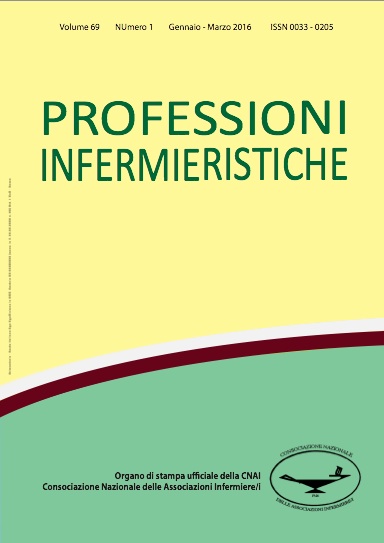Contenuto dell'articolo principale
Abstract
Lo studio operativo quinquennale si pone come ambizioso obiettivo quello di ridurre l'incidenza del kwashiorkor (marasma infantile) attraverso un approccio olistico esclusivamente infermieristico alle famiglie che vivono il problema nella realtí straniera del Kenya rurale. Progetto finanziato dal fondo "Tesi cooperazione internazionale" dell' ERSU Sardegna, basato su un viaggio effettuato a luglio/agosto 2012 volto all'osservazione dell'ambiente , dei pazienti, della patologia e della cultura locale. Attraverso l'utilizzo del problem solving potrebbe essere ridotta l'incidenza del kwahiorkor usando come strumento la prevenzione primaria sotto forma di conoscenza: ovvero la consegna di una serie di brochures realizzata in Italia e distribuita direttamente dagli infermieri locali in servizio presso il Consolata Hospital di Nyeri ad ogni puerpera ospedalizzata, contenenti una guida al corretto svezzamento basata sulle linee guida OMS e personalizzata per l'economia e la cultura -anche alimentare- locale, appresa durante il viaggio sovracitato. L'efficacia dello studio verrí poi valutata per 5 anni a intervalli regolari di un anno, rapportando l'incidenza di kwashiorkoar ospedalizzato presso la stessa struttura col numero di brochures consegnate e confrontando questo risultato con i tassi di incidenza rilasciati dalle organizzazioni non governative per la stessa zona d'interesse.
Parole chiave: Kwashiorkor, marasma, prevenzione primaria, infermiere, PEM.
Child mortality in Africa: a nursing approach to Kwashiorkor
The five year operative study points the ambitious aim of reducing kwashiorkor's incidence through an holistic approach to the families that live the issue in the rural Kenya reality. The project had been financed with the "Tesi cooperazione internazionale" funds of ERSU Sardegna, based on a trip made in July/August 2012 that was aimed at observing the environment, the patients, the pathology and the local culture. Using the problem solving method, the kwashiorkor's incidence could be decreased with the primary prevention tool as a form of knowledge through brochures made in Italy and delivered directly by the local nurses of the Consolata Hospital in Nyeri to women who have just given birth. The brouchure contains a guide to the correct way of weaning, based on the OMS's guide lines and customized for the local economy and culture (food culture too), learned during the trip. The effectiveness of the study will be valuated for 5 years (with regular pauses of a year each) comparing the Hospitalized Kwashiorkor's incidence, to the number of brochures delivered and then comparing these results to the incidence rates released by the NGO for the same zone of interest.
Keywords: Kwashiorkor, marasma, primary prevenction, nurse, PEM.
Dettagli dell'articolo
Riferimenti
- Cicely D., Williams, B.M. (1933) A nutritional disease of chld-hood associated with a maize diet, from the Children's hospital, Acera, Gold Coast colony.
- Krawinkel, M. (2003) Public Health Classics, Kwashiorkor is not fully understood. Bulletin of World Health Organization.
- -Kondi, A., Macdougall, L., Foy, H., Sudha Metha Mbaya,V. (1962). Aenemias of marasmus and kwashiorkor in Kenya. Wellcome Trust Research Laboratories.
- -Brock, J.F. , D.M., F.R.C.P. (1952) Kwashiorkor in Africa World Health Organization, Palais des nations, Geneva. Monograph series no. 8.
- Nyikal, j. (2011) Paediatric Protocols , MBS from Republic of Kenya, Ministry of Health.
- WHO 10-13 December. (2001). The Global Consultation on Complementary Feeding.
- Ubesie, A.C., Ibeziako, N.S., Ndiokwelu, C.I., Uzoka, C.M., Nwafor, C. (2011) Under-five Protein Energy Malnutrition Admitted at the University of In Nigeria Teaching Hospital, Enugu: a 10 year retrospective review. Nutritional Journal, Vol. 11.
- Pan American Health Organization. (2003).The Guiding Principles for Complementary feeding of the Breastfed Child.
Riferimenti
Cicely D., Williams, B.M. (1933) A nutritional disease of chld-hood associated with a maize diet, from the Children's hospital, Acera, Gold Coast colony.
Krawinkel, M. (2003) Public Health Classics, Kwashiorkor is not fully understood. Bulletin of World Health Organization.
-Kondi, A., Macdougall, L., Foy, H., Sudha Metha Mbaya,V. (1962). Aenemias of marasmus and kwashiorkor in Kenya. Wellcome Trust Research Laboratories.
-Brock, J.F. , D.M., F.R.C.P. (1952) Kwashiorkor in Africa World Health Organization, Palais des nations, Geneva. Monograph series no. 8.
Nyikal, j. (2011) Paediatric Protocols , MBS from Republic of Kenya, Ministry of Health.
WHO 10-13 December. (2001). The Global Consultation on Complementary Feeding.
Ubesie, A.C., Ibeziako, N.S., Ndiokwelu, C.I., Uzoka, C.M., Nwafor, C. (2011) Under-five Protein Energy Malnutrition Admitted at the University of In Nigeria Teaching Hospital, Enugu: a 10 year retrospective review. Nutritional Journal, Vol. 11.
Pan American Health Organization. (2003).The Guiding Principles for Complementary feeding of the Breastfed Child.

